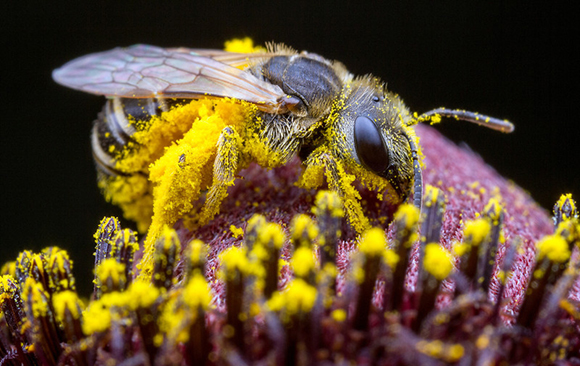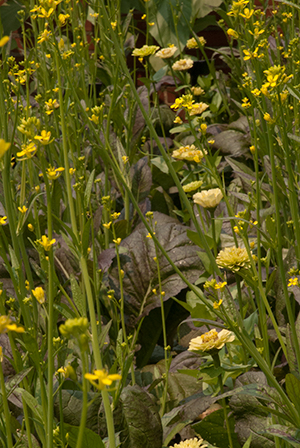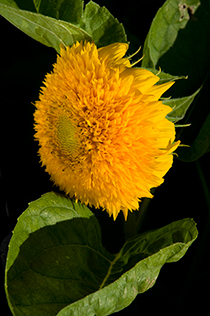Changing your planting style is a win-win for you and your local bees.
At the Regenstein Fruit & Vegetable Garden, horticulturist Lisa Hilgenberg is planting for pollination success. "It's actually been good for us that the weather stayed cool for so long," said Hilgenberg. "Earlier this season we were about a month behind schedule — we had difficulty getting bees. Our suppliers were short hives."
After an early spring conference on managing bees for optimal pollination, she's trying some new planting combinations "in the field." Using Lisa's techniques, you can increase your garden's yield and improve the health of your neighborhood bee population, too.

A sweat bee (Halictus ligatus) covered in Rudbeckia pollen, which the bee gathers to feed to her larvae. Photo by Alex Wild
Not all bees pollinate the same way
Did you know that some bees are better than others at pollinating certain plants? Blueberries are a great example—the flowers don't easily release pollen. The first day of flower opening is the most important day for pollination, as the fruit set will be better. As the flower ages, this likelihood declines, and bad weather can complicate pollination even more.
- Wild bees such as bumblebees, sweat bees, or mason bees can pollinate in only one visit, and much prefer foraging in blueberries than the honey bee—which would need three or more visits to get the same job done!
- Bumblebees, however, can fly at much lower temperatures than native bees and buzz pollinate (vibrating the flower to release the pollen). When it's hot, the honeybee may get the job done more efficiently—their sheer numbers pay off in a shorter bloom time.
Give bees something to love all season
Plant continuously blooming annuals in your garden to encourage visitors all season long. Bee favorites include sweet allysum (Lobularia maritima), lesser calamint (Calamintha nepeta), and plants in the Asteraceae family such as coreopsis or cosmos, which can repeat-bloom when deadheaded.
Groupings of native perennials blooming in sequence can also bring in other attractive pollinators like hummingbirds and butterflies. Consider Salvia and butterfly weed (Asclepias tuberosa) in spring, and Coneflower (Echinacea) or goldenrod (Solidago) for late summer, with asters in the fall.
Get rid of the rows and mix it up!
 It has long been known that planting marigolds with tomatoes repels a host of pests, but what about planting to attract bees as well? "We planted borage (Borago officinalis 'Alba') in two places this year—an interesting, smaller, white-flowered borage, which attracts honeybees, deters cabbage worms, and has an edible flower," said Hilgenberg.
It has long been known that planting marigolds with tomatoes repels a host of pests, but what about planting to attract bees as well? "We planted borage (Borago officinalis 'Alba') in two places this year—an interesting, smaller, white-flowered borage, which attracts honeybees, deters cabbage worms, and has an edible flower," said Hilgenberg.
In a test bed on the north side of the garden, find the yellow-green heads of pest-deterring zinnias (Zinnia elegans 'Envy') between the broad, dark purple leaves of red giant mustard (Brassica juncea 'Red Giant').
Perennial yarrow also makes a great companion to a vegetable bed, attracting not only bees, but also ladybugs, which consume masses of aphids. Interplanting not only increases your yield on bee-pollinated crops, it's good for the health of your garden, and it looks beautiful.
Plant sunflowers
 As part of a multiyear study (www.greatsunflower.org), more than 100,000 citizen scientists across Canada and the United States are counting the number of bee hits to their Lemon Queen sunflowers (Helianthus annuus 'Lemon Queen"), an incredibly popular cultivar among native bees. These sunflowers are planted in the west lake trellis of the Fruit & Vegetable Garden, where they will grow up to 5 feet tall, attracting pollinators to their companion plantings of small mixed gourds (Cucurbita pepo) and showy amaranth (Amaranth 'Autumn Palette'). At the entrance to the garden, Teddy Bear sunflowers (Helianthus annuus 'Teddy Bear') are interplanted with Honey Bear acorn squash (Cucurbita pepo 'Honey Bear').
As part of a multiyear study (www.greatsunflower.org), more than 100,000 citizen scientists across Canada and the United States are counting the number of bee hits to their Lemon Queen sunflowers (Helianthus annuus 'Lemon Queen"), an incredibly popular cultivar among native bees. These sunflowers are planted in the west lake trellis of the Fruit & Vegetable Garden, where they will grow up to 5 feet tall, attracting pollinators to their companion plantings of small mixed gourds (Cucurbita pepo) and showy amaranth (Amaranth 'Autumn Palette'). At the entrance to the garden, Teddy Bear sunflowers (Helianthus annuus 'Teddy Bear') are interplanted with Honey Bear acorn squash (Cucurbita pepo 'Honey Bear').
Start a trend in your neighborhood and give your garden a bee makeover.
Karen Zaworski is a garden writer and photographer who lives and gardens in Oak Park, Illinois.

